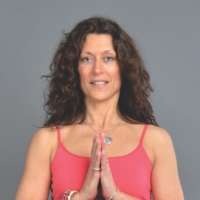
Due to its many health benefits, Supported Shoulderstand posture has been given the nickname “Queen” or “Mother Asana.”
Karen Britton
Supported Shoulderstand
Due to its many health benefits, Supported Shoulderstand posture has been given the nickname “Queen” or “Mother Asana” (posture). B.K.S. Iyengar, one of the great yoga teachers, wrote a wonderful and complete book on yoga called “Light on Yoga.” It is a must-read for anyone interested in yoga. In it, he says that shoulderstand (body inverted with feet above head) is a solution or remedy for all difficulties or diseases. According to Iyengar, this posture has a direct effect on the thyroid and parathyroid glands. Other benefits include increased venous blood flow to the heart and increased blood supply to the neck and chest. It may also help with palpitations, asthma, bronchitis and throat ailments. It can calm one’s nerves and soothe headaches. Iyengar also states it can relieve hypertension, irritation, short temper, and insomnia and while reducing fatigue. It further helps with digestive and elimination disorders such as irregular bowel movements. It can even reduce symptoms of menopause. Finally, shoulderstand pose stretches the neck and shoulders and tones the core, legs, and buttocks. Now you know why it is called “Mother Asana!”
My own personal experience with shoulderstand was that is helped my cervical spine (neck) tremendously. After being in a car accident where my neck was injured, my doctor approved me to practice this posture. In addition to other yoga postures, this pose was one of the critical components that helped my neck feel much better.
I’m sure you’ve experienced over-worked legs, whether from a good work out or just living life. Any variation of shoulderstand can relieve achy feet, legs, and hips.
Supported Shoulderstand (Images 1-3 from the left to right, above)
Supported shoulderstand is with hands placed on the lower back for support. With regular practice, your shoulders will become stronger and more flexible, allowing you to work your elbows in towards the spine, shoulder-width apart, so that you may place the palms of your hands at your lower back with fingertips pointing up and pinkies resting on the spine (see image 2). This will allow your feet, hips, and shoulders to be stacked over each other.
Half-Shoulderstand (4th image from the left, above)
It may be best to start with half-shoulderstand, which has a hinge at the hips. In this modification, the body will not be perpendicular to the floor. Your feet will be over your head and hips and away from your shoulders. This variation can take pressure off your neck.
Modifications
Props can also be used to support your neck and shoulders, such as placing a folded blanket under your shoulders with your shoulder blades resting on the blanket. The top edges of the shoulders should be in line with the top edge of the blanket. The blanket should be approximately 3 inches high.
The Restorative Version (5th image from the left, above)
If supported shoulderstand does not work for you, there’s a very relaxing restorative alternative. Keep your back on the mat supported by a bolster or block at your lower back, then bring your legs up overhead. The flow of blood is reversing itself down the legs to hips, back, heart, and brain, resulting in a very relaxed state that releases stress and mild depression. An even more calming and accessible position is to lie on the floor, resting your legs upward above your head against a wall for support. Your lower back can be supported with a bolster, block, or blanket. No experience is needed to do this pose. If you can get down on the floor and get up again, then you can do it. The longer held the more tranquil one becomes. When legs are inverted, they become warm, light, weightless, almost as if they have disappeared. They feel as if they had a massage. (see image 4 above)
Before You Start
Your body should be warm before trying the pose. Unless you’re doing a restorative version, never turn your head as you might strain the neck. Should you suffer from high blood pressure, avoid the full or half version unless doctor-approved and under the supervision of a qualified instructor.
Variations, excluding the restorative version, should be worked up to with regular practice. Bridge pose is a good prep pose. However, one should practice prep poses for a while before attempting the shoulderstand.
You will benefit from many yoga postures, and, when ready, adding the full or half shoulderstand as part of your practice is like putting a cherry on top. But it’s important to remember there’s more to yoga than just the cherry.
Sponsored Links
About the Author

Karen Britton
Karen Britton is a certified Yoga Instructor and a regular contributor to Fit to Print. She teaches Yoga classes and programs at Fitness Incentive.

